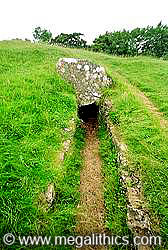
 |
|
Photo Gallery |
|
|
VR Tour |
|
| SO 78963 00043 (GPS 47min) | |
| Visited Aug 1995/ June 2000 |
Hetty Pegler's Tump is named after a 17th
century owner of the field, a Hester Pegler, it is also known as the Uley Long
Barrow. The Tump belongs to a class of monuments known as Cotswold- Severn Long
Barrows or Cairns. The mound is of average size, being 36m long, 24m wide and 3m
high. A modern pathway leads through the original forecourt area to the
entrance, this is about 1m high and surmounted by a huge portal stone. This
unusual feature is probably the result of a passage capstone being wrongly
placed during the restorations of the 1800s. Inside is
a passage about 7m long with two side chambers opening off to the south, the end
of the passage itself forming a third terminal chamber. This is an unusual
layout for barrows of this type, multiple chambers usually have a transepted
arrangement, being paired on either side of the passage. Originally, there were
two further chambers in the north passage wall, but these were blocked off in
the excavation of 1821, hence the aberrant layout seen today. Other transepted
barrows of this type have been radiocarbon dated to 3300-3200BC. The remains of
19-20 people were found in and around the chambers during the excavations of
1821 and 1854. The pattern of use seems to have been
multiple inhumation added over time, the bones being disturbed, and perhaps
removed occasionally for ritual use. The discovery of articulated skeletons as
final burials in other barrows of this type suggests that excarnation prior to
deposition was not customary.
If you decide to visit Hetty Pegler's you will need artificial illumination to examine the
interior properly, and be warned that the interior can get a bit boggy in wet
weather.
We noticed a lot of newly carved graffiti and candle stubs/ wax spills on our
last visit, sadly, we are seeing more and more of this kind of recent defacement at the
sites we revisit. These special places have survived thousands of years to reach
us, please allow them passage through our time without damage.